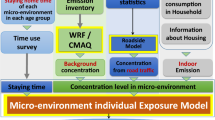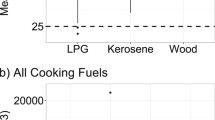Abstract
In order to evaluate the exposure of the northern India rural population to polyaromatic hydrocarbon (PAH) inhalation, indoor pollution was assessed by collecting and analyzing the respirable particulate matter PM2.5 and PM10 in several homes of the village Bhithauli near Lucknow, UP. The home selection was determined by a survey. Given the nature of biomass used for cooking, homes were divided into two groups, one using all kinds of biomass and the second type using plant materials only. Indoor mean concentrations of PM2.5 and associated PAHs during cooking ranged from 1.19 ± 0.29 to 2.38 ± 0.35 and 6.21 ± 1.54 to 12.43 ± 1.15 μg/m3, respectively. Similarly, PM10 and total PAHs were in the range of 3.95 ± 1.21 to 8.81 ± 0.78 and 7.75 ± 1.42 to 15.77 ± 1.05 μg/m3, respectively. The pollutant levels during cooking were significantly higher compared to the noncooking period. The study confirmed that indoor pollution depends on the kind of biomass fuel used for cooking.
Similar content being viewed by others
References
Air Metrics (2004). Minivol portable air sampler description. http://www.airmetrics.com/products/minivol/index.html.
Balkrishnan, K. J., Parikh, S., Shanker, R., Padmavathi, R., et al. (2002). Daily average exposure to respirable particulate matter from combustion of biomass fuels in rural home holds of Southern India. Environmental Health Perspectives, 110, 1069–1975.
Bhargava, A., Khanna, R. N., Bhargava, S. K., & Kumar, S. (2004). Exposure risk to carcinogenic PAHs in indoors-air during biomass combustion whilst cooking in rural India. Atmospheric Environment, 38, 4761–4767.
Bruce, N., Perez-Padilla, R., & Albalak, R. (2000). Indoors air pollution in developing countries: A major public health challenge. Bulletin World Health Organisation, 78, 1078–1092.
Cohen, A. J., Anderson, H. R., Ostra, B., Pandey, D. K., Krzyzanowski, M., Kunzi, N., et al. (2005). The global burden of disease due to outdoor air pollution. Journal of Toxicology and Environmental Health, Part A, 68, 1–7.
Cooper, J. A. (1980). Environmental impact of residential wood combustion emission and its implications. Journal of Air Pollution and Contamination Assessment, 30, 855–861.
Diapouli, E., Chaloulakon, A., & Syyrellis, N. (2007). Indoor and outdoor particulate matter concentrations at schools in the Athens area. Indoor Built Environment, 16, 55–61.
Environmental Protection Agency (1986). Test method for evaluating solid and waste. Laboratory manual/chemical manual SW-846 (vol. 1B). Washington DC, USA. http://www.who.int/indoorair/en/. Accessed 30 Apr 2008.
ICMR-Indian Council of Medical Research (2001). Indoors air pollution in India—A major environmental and public health concern. ICMR Bulletin, 31, 0377–4910.
International Institute for Population Sciences (1995). National Family Health Survey (MCH and family planning): India 1992–93. International Institute for Population Sciences, Mumbai.
Jianali, N., Brain, M. K., Thomas, L. U., & Tung, C. W. (2002). Instrumentation issue in indoor air quality measurements: The case with respirable suspended particulates. Indoor Built Environment, 11, 162–170.
Khillare, P. S., Pandey, R., & Balachandran, S. (2004). Characterization of indoor PM10 in residential areas of Delhi. Indoor Built Environment, 13, 139–147.
Mishra, V. K., Retherford, R. D., & Smith, K. R. (1999). Biomass cooking fuels and prevalence of blindness in India. Journal of Environmental Medicine, 1, 189–199.
Naeher, L. P., Brauer, M., Lipsett, M., Zelikoff, J. T., Simpson, C. D., Koenig, J. Q., et al. (2007). Wood smoke health effects: A review. Inhalation Toxicology, 19, 67–106.
Peabody, J. W., Riddell, T. J., Smith, K. R., & Liu, Y. (2005). Indoor air pollution in Rural China: Cooking fuels, stoves and health status. Archives of Environmental and Occupational Health, 60, 86–95.
Robin, L. F., Less, P. S. J., Winger, M., Steinhoff, M., Moulten, L. H., Santoshom, M., et al. (1996). Wood-burning stoves and lower respiratory illness in Navajo children. Pediatric Infectious Disease Journal, 15, 859.
Rosemarin, A. (2002). Making green development a choice, China Human Development Report. Oxford: Oxford University Press.
Saxena, S., Prasad, R. K., & Shankar, V. R. (2007). Daily exposure to air pollutants in indoor, outdoor and in-vehicle microenvironments: A pilot study in Delhi. Indoor Built Environment, 16, 39–49.
Seppo, T., Renne, E. J., Rodas, B. S., Bender, M. L., Renne, J. M., et al. (2006). Relationship of pulmonary function among women and children to indoor air pollution from biomass use in rural Ecuador. Respiratory Medicine, 100, 1208–1215.
Smith, K. R. (1990). Indoor air quality and the population transition. In H. Kasuga (Ed.), Indoor air quality (p. 148). Berlin: Springer.
Smith, K. R. (1997). Kitchen kills more than sword: Hazard’s of world second most common workplace. For presentation at the indoor air quality symposium, Dallas, Texas.
Smith, K. R. (2000a). Indoor air pollution implicated in alarming health problems. In Indoor air pollution-energy and health for the poor. Newsletter published by World Bank.
Smith, K. R. (2000b). Inaugural article: National burden of disease in India from indoor air pollution. Publication of National Academy of Science, 97, 13286–13293.
Smith, K. R., & Mehta, S. (2003). The burden of disease from indoor air pollution in developing countries: comparison of estimates. International Journal of Health and Environmental Hygiene, 206, 279–289.
Smith, K. R., Mehta, S., Maeusezahl, F. M. (2004). Indoor smoke from home hold solid fuels. In M. Ezzati, A. D. Rodgers, A. D. Lopez, & C. J. L. Murray (Eds.), Comparative quantification of health risks: Global and regional burden of disease due to selected major risk factors (Vol. 2, pp. 1435–1493). Geneva: World Health Organization.
Smith, K. R., Samet, J. M., Romieu, I., & Bruce, N. (2000). Indoor air pollution in developing countries and acute lower respiratory infections in children. Thorax, 55, 518–532.
Tsai, F. C., Smith, K. R., Vichit, V. N., Ostro, B. D., Chestnut, L. G., & Kungskulniti, N. (2000). Indoor/outdoor PM2.5 and PM10 in Bangkok, Thailand. Journal of Exposure Analysis and Environmental Epidemiology, 10, 15–26.
World Health Organization Europe (1997). Air quality guidelines for Europe. Series no. 23. Copenhagen: World Health Organization Europe, Regional Office for Europe.
World Health Organization (2002). Indoor air pollution. World Health Report. Available at: World Resources Institute (WRI), 1998–99. United Nations Environment Programme, United Nations development programme and World Bank. 1998–99 World Resources: A Guide to the global environment, Oxford University Press, Oxford.
Author information
Authors and Affiliations
Corresponding author
Rights and permissions
About this article
Cite this article
Ansari, F.A., Khan, A.H., Patel, D.K. et al. Indoor exposure to respirable particulate matter and particulate-phase PAHs in rural homes in North India. Environ Monit Assess 170, 491–497 (2010). https://doi.org/10.1007/s10661-009-1249-2
Received:
Accepted:
Published:
Issue Date:
DOI: https://doi.org/10.1007/s10661-009-1249-2




